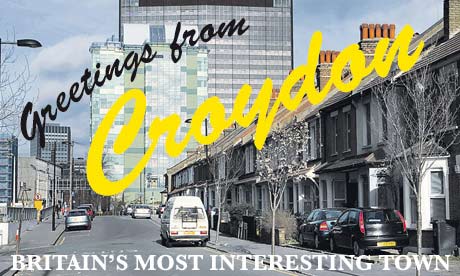
And so to the top of a windswept multi-storey car park in Croydon, to take in the view on a day when the drizzle is face-slappingly sharp and it's so cold you can no longer feel your toes. On a good day, you can see Wembley stadium in London to the north, and the downs to the south, but all I see is grey. Welcome to "Britain's most interesting town". Who says? "Well, I do," says James Naylor, who has been running Croydon Tours since last month.
Not many would agree. Is there anything worth seeing in the town? "Not really," says Wendy Thomas, standing outside the Whitgift shopping centre. "It needs a facelift." Would anyone advise tourists to visit? "Probably not," says Marius, a catering manager from Poland who has lived in the town for 11 years. "It used to be a nice place and it's good for businesses, but there are too many drunk people."
Naylor, a young man of extreme enthusiasm, isn't deterred. "Most local people are not particularly proud of Croydon because they don't know there is a lot to be proud of," he says. He wants to "reveal all the interesting things it has to offer. More than any other town in Britain, it has kept some aspects of all its history from the middle ages. It boomed during the Industrial Revolution, and again in the 1920s and 1930s when it had London's main airport, and again post-war when office blocks shot up. Now, it's one of the most multiculturally interesting parts of the country."
We start walking around the town and Naylor points out places of interest – a small dwelling with parts dating back to the 15th century (now a KFC); Surrey Street, which has been home to a street market since 1276; around the corner, an old pumping station that used to supply Croydon's water; Croydon Palace, the summer residence for 500 years' worth of Archbishops of Canterbury; brutalist towers; art-deco shop fronts; the furniture store that was burned down in the riots last year. "Croydon is a hotch-potch," admits Naylor. "But I think that makes it more intriguing."
There are old brick warehouses – a reminder of the town's industrial past – just a few minutes walk from the shopping centre, once the biggest in Europe when it opened in 1970. Every time you look skywards, you can see 1960s office blocks. One of them doubles up as JLB Credit, where Mark works in Peep Show (Naylor also runs tours of the locations used in the Channel 4 show). Few places can speak more clearly of Britain's transition from manufacturing power to a place built on shopping, services and middle-management jobs you don't really understand. So, strangely enough, Croydon turns out to be rather interesting after all.

